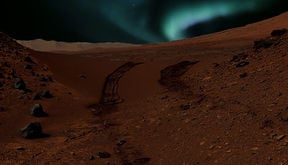Similarities between aurorae on Mars and Earth

Blue aurorae on Mars: an artist interpretation of what aurorae may look like as seen by the NASA Curiosity rover, were it close to magnetic anomalies on Mars. Photomontage (c) NASA/JPL-Caltech/MSSS and (c) CSW/DB
Mars' upper atmosphere may be indeed closer to Earth's than previously thought. Researchers showed that the upper atmosphere of Mars glows blue depending on the activity of the Sun. The result was achieved through numerical simulation and a laboratory experiment, called the Planeterrella, used to simulate the aurora. The study was published in the leading planetology publication Planetary and Space Science on 26 May.
– The study indicates that one of the strongest colours in the Martian aurorae is deep blue. Green and red also occur, just like on Earth. An astronaut looking up while walking on the red Martian soil would be able, after intense solar eruptions, to see the phenomena with the naked eye, says researcher Cyril Simon Wedlund of Aalto University's Department of Radio Science and Engineering.
Prediction of multicolour aurora at Mars
The aurorae on Mars were observed for the first time in 2005 with the help of the European Space Agency ESA's Mars Express satellite. The new prediction is based on a laboratory experiment conducted with the Planeterrella simulator and a theoretical and numerical model developed by the Grenoble Institute of Planetology and Astrophysics (IPAG, France) and NASA.
– The Planeterrella experiment was conducted in France. We replicated the gas of the atmosphere with the most common component on Mars, which is carbon dioxide, after which an electrical discharge was created in a vacuum reminiscent of the Martian upper atmosphere, which led to the formation of a blue glow following the magnetic field structure, Simon Wedlund says, explaining the experiment.
The present study shows that, on Mars, aurorae also occur in the visible range. Aurorae occur when electrically charged particles of solar origin are driven down along the local magnetic field lines, where they enter the planetary atmosphere and excite its atoms and molecules. On Earth, aurorae are essentially green or red, from atomic oxygen, but even blue-purple, from ionized molecular nitrogen, can be seen.
Only 17 Planeterrellae simulators are currently in use in different parts of the world. Aalto University has developed the first Planeterrella simulator in the Nordic Countries, derived from the one used in this study but with a larger tribute to the historical Birkeland Terrella. The first laboratory experiments are to be conducted by the end of the year.
Prediction of blue, red and green aurorae at Mars by J. Lilensten, D. Bernard, M. Barthélemy, G. Gronoff, C. Simon Wedlund, A. Opitz, Planetary and Space Science, May 2015, PII : S0032-0633(15)00130-0, DOI : 10.1016/j.pss.2015.04.015
More information:
Researcher Cyril Simon Wedlund
Aalto University
School of Electrical Engineering
[email protected]
tel. +358 50 448 1280
- Published:
- Updated:
Read more news

Get to know us: Associate Professor Maria Sammalkorpi
Sammalkorpi received her doctorate from Helsinki University of Technology 2004. After her defence, she has worked as a researcher at the Universities of Princeton, Yale and Aalto.
Aalto computer scientists in ICML 2024
Computer scientists in ICML 2024
In low-hierarchy organisations, even key policy issues are discussed in Slack
In a recent study, Aalto University alumn Lauri Pietinalho, a visiting scholar at New York University's Stern School of Business, and Frank Martela, an assistant professor at Aalto University, investigated how low-hierarchy organisations deal with shared policies in confrontational situations and how authority functions within them.